Copyright © 2000 by James Pritchett. All rights reserved. This work was made possible by the Getty Research Institute, through their visiting scholars program.
Introduction
David Tudor had at least two careers. The first was as a performer of avant-garde music in the 1950s and 60s. The second was as a composer of music using live electronics. There is relatively little overlap in these careers; Tudor ceased performing other people’s works about the same time in the mid-1960s that he began creating his own. And yet, so many of the performances he created in the later 1950s and onward involved electronics and amplification, that it would seem likely that the roots of his life as a composer are to be found here.
This paper identifies and documents one case that confirms this theory. Here I will explain how Tudor created his performance of John Cage’s composition Variations II, a realization that Tudor created for the amplified piano. Drawing upon original manuscript documents in the Tudor collection at the Getty Research Institute, I will show how this specific realization represents an emergence of Tudor’s compositional voice, even as it continues his tradition as a performer of Cage’s music.
1. Cage’s Variations II
Variations II represents the greatest degree of abstraction of a compositional and notational model that Cage developed over the period from 1958 to 1961. The basic mechanism is very simple: interpreting the distance from a point to a line as a measurement of a musical parameter. The premise of such a notation is thus that each line represents an axis of measurement for a given parameter (or more properly, a perpendicular to an axis of measurement). Using measurements of graphic space as a way of determining the values of sonic parameters in this fashion was an integral part of many Cage notations in the 1950s, including a host of notations in the Solo for Piano (1958). Most of these, however, limit themselves to a two-dimensional space that describes the parameters of pitch and time. In notation BB of the Solo for Piano, however, there are five axes and hence the points may be seen as existing in a five-dimensional space. In the notation, five lines and twelve points are arranged randomly. The twelve points represent twelve individual sounds; the five lines represent five parameters of sound (amplitude, duration, overtone structure, frequency, point of occurrence within the whole time-frame). For each of the twelve points, measurements are made of the distances to each of the five lines. These distances are interpreted as values for the associated parameters. Cage does not specify the scale of measurement to be used — this is the source of indeterminacy in this notation.
In notation BV of the Solo for Piano, the five lines are interpreted in the same manner, although there are no fixed associations of lines with specific parameters. Another difference is that the dots in BV represent events rather than individual sounds. The largest dots are events of four notes, the next smaller dots are events of three notes, etc. For events of more than one note the performer makes a different association of lines with parameters for each note. This notation thus exponentially increases the interpretive possibilities of the dot-and-line notation by removing the fixed definitions of the five axes of measurement.
The first of the Variations pieces, composed in 1958, takes notation BV a step further. Here again dots of different sizes represent events of differing numbers of notes and five lines to use as axes of measurement for five sonic parameters. The difference in the Variations I is that the dots and lines are drawn on transparent plastic which allows the interpreter to relate them in many different ways. There are six squares of transparent plastic in the score. The twenty-seven dots of different sizes are printed on one of these. The other five each have a particular random configuration of five lines printed on them. To make a realization of the piece, the performer overlays one of the sheets of lines on the sheet of points and then proceeds just as with notation BV in the Solo for Piano. For events with multiple notes, the performer changes the orientation of the sheet of lines to get different readings for each note, or the performer may use different sheets of lines for each note.
The use of plastic sheets takes notation BV and opens it up by removing the fixed relations between the line configurations and the points. To extend the music further, Cage later created a set of additional line sheets to create even more possible arrangements. Each of these different arrangements of lines describes a different five-dimensional space in which the sounds occur. The use of transparencies thus increased the variability in the dot-and-line notation exponentially again.
Variations II was composed in 1961 and takes the dot-and- line notation one step further. In this work there are only eleven pieces of transparent plastic. Five of these are small squares with a single dot printed on them, and the other six are rectangular and bear a single line. To interpret the piece, the performer arranges these eleven elements in any way and then measures distances from points to lines, just as in the earlier dot-and-line works. The sixth line, a new element in this work, is the axis of measurement for “structure of event”. Measurements taken on this axis fill the role that the different sizes of dots did inVariations I: they are used to determine the number of notes in the event.
Placing each individual dot and line on a separate sheet of transparent plastic completes the process of abstracting and opening up this notation. With Variations II, any configuration of dots and lines is possible, and hence any sound can be described in this notation. Beyond this, the performer makes as many arrangements of dots and lines as they wish to create a realization. This means that a performance of Variations II can consist of any number of sounds taken from the entire range of sounds that can be described. And if this was not expansive enough, Cage adds the following instruction that opens the score further: “If questions arise regarding other matters or details … put the question in such a way that it can be answered by measurement of a dropped perpendicular.” Another way of stating this is that additional parameters of sound may be added to the interpretation; not only the number of dots, but the number of lines in this score can be increased as needed by simply rearranging the materials and making more measurements. Given this enormous flexibility, it is not an exaggeration to say that the Variations II encompasses any piece of music that could possibly be created. All that is required is that the parameters of the piece be identified and measured in the proper way.
However, Cage’s instructions make it clear that he saw the variables to be the same ones he had been working with throughout the 1950s. The identification of frequency, amplitude, timbre, and duration as the fundamental characteristics of sound was a refrain that appears throughout much of Cage’s writing on music in the 1950s. And in describing the structures of events he uses the terms “constellation” and “aggregate”, terms that refer to musical elements he had identified in the charts of his Music of Changes in 1951. “Point”, “Aggregate”, and “Constellation” were also the three structural types used in the works 31′ for a pianist and 34′ for a pianist. The instructions to Variations II thus suggest that Cage saw this piece as another way to build music using the same structural elements that he had been using throughout the 1950s.
2. Tudor’s realization
The instrument
David Tudor’s 1961 realization of the Variations II is for amplified piano. As Tudor indicates in his notes regarding the realization, this is not just a score for a piano that happens to be amplified:
My realization of Variations II evolved from a decision to employ the amplified piano, conceived as an electronic instrument, whose characteristics orient the interpretation of the six parameters to be read from the materials provided by the composer.
Tudor was clearly thinking of the amplified piano as something greater than the sum of its parts (piano and electronics). Here it is a unified electronic instrument with its own characteristics that must be addressed in the realization.1
The amplification setup used is described in some detail in an interview Tudor gave with Frank Hilberg in 1990.2 The piano was amplified via three different devices. First, there were microphones placed above and below the piano. Secondly, there were contact microphones attached to the piano, or to automobile “curb-scrapers” (essentially stiff wire springs) that could be used to play the strings of the piano. Finally, Tudor used phonograph cartridges with various objects inserted into them. These cartridges could be used to scrape the piano strings, or could be placed so as to conduct the vibrations of the strings. The signals from these various microphones were mixed together, amplified, and played through speakers in the same space as the piano. The damper pedal of the piano was held down throughout so that the strings could vibrate freely.
This setup produces a number of feedback loops. Playing on the strings of the piano excites the various microphones in different ways depending on their placement and nature. When these signals are amplified and played back into the space, feedback is communicated directly through the microphones, but also through the sympathetic vibration of the strings of the piano. The whole system presents a very complex interaction of its various parts. Adjusting the levels of the various microphone signals, the ways in which the cartridges are deployed in the piano, and the ways in which the piano is played will alter the behavior of the whole system.
However, the system is so complex that its behavior can never be totally predicted: the amplification of the piano made it, to some degree, an uncontrollable instrument. Tudor’s own characterization of it was that he “could only hope to influence” the instrument — he could not predict the nature of the sounds that would result from a particular action.3 This unpredictability was to be the controlling factor in Tudor’s realization of Variations II, as will be seen.
The score
Tudor’s first notes towards a realization (transcribed in Figure 1) closely follow Cage’s measurement model. He listed the six parameters and a sense of how they could be measured: frequency could be low to high (“LMH” here means “Low Medium High”); point of occurrence was within a twenty-minute duration; duration was short to long (“SML” here means “Short Medium Long”); amplitude was soft to loud (“SML” here means “Soft Medium Loud”); overtone structure (here abbreviated as “o.s.”) was an arbitrary scale that ran from “natural” to “chaotic”; and structure of event was interpreted as “degree of aggregation”, running from single to “manifold”. These notes are accompanied by a list of different types of actions that could be made with an amplified piano, along with what appears to be an attempt to categorize the actions by complexity of overtone structure.
This approach could have formed the basis for a realization of the Variations II that stayed close to the model of the Variations I. Tudor’s realization of the Variations I indeed used very strict measurements along different scales for the different sonic parameters. (actually, he created three different realizations using the same basic method applied to three different total durations). The initial notes for the Variations II realization suggest that he was looking for similar scales that could be used for an amplified piano.
This model was abandoned early on and the realization took a sharply different direction. A later version of the same outline of the six parameters (transcribed in Figure 2) lists only two possible values for each parameter: simple or complex. This in effect removes the concept of measurement from the piece altogether. The six parameters are no longer conceived as continua in which linear measurements are made. Instead they are binary variables capable only of switching between two discrete values. Exactly what was meant by “simple” and “complex” is open to discussion, and Tudor’s own comments are not consistent in this regard. I will address this in the third section of this article when I address Tudor’s performance of the piece. What is most important to note at this point is that Tudor’s simplification of the measurement system to a binary choice takes the notation of Variations II away from Cage’s conception and into a wholly unexpected realm. For Cage, the sonic parameters were analogous to the dials of an imaginary sound synthesizer; Tudor’s “simple/complex” switches represent a different interface between the musician and sound, one that includes the “black box” of the amplified piano inserted between them.
The realization proceeded from this model. Tudor made fifty sets of measurements and notated the results on graph paper. Figure 3 is a transcription of two such sets of measurements. Each reading was represented as a five-by-five grid with an additional modifier. The first four rows of the grid describe (from top to bottom) the parameters of timbre, frequency, duration, and amplitude. A dot appears either in the rightmost or leftmost column for each of these, indicating a value of “simple” or “complex”, respectively. The bottom row of the grid describes the point of occurrence. This is represented by either a dot or an X located on one of the six vertical lines of the grid. In this case, the use of a dot or an X represented the values of “simple” and “complex”. The horizontal placement of the mark was used in determining exactly when the event would begin, as will be described below. Finally, each of the grids is accompanied by a letter “S” or “C” to the side. These notations represent the value of the “structure of event” parameter (simple or complex).
Tudor made no further determinations, measurements, or refinements to these readings. His final notation for the realization was simply a simpler version of the grids. Figure 4 is a transcription of the final rendition of the two grids of Figure 3. Each event is notated as a square; the dots for the parameters of timbre, frequency, duration, and amplitude have been changed into short horizontal lines intersecting the left or right side of the square. The point of occurrence is still notated horizontally as a point along the bottom of the square, although “simple” and “complex” values are now shown as a single dot or a circled dot, respectively. Finally, the value for structure of event is notated here as a single border (simple) or double border (complex).
The fifty events were notated in this manner on three narrow pieces of heavy paper. Each piece has a single row of events on either side. Tudor referred to these notations as “nomographs”. Their most important characteristic is that they expressed all the information needed in a compact, easily-scanned format. He describes them as “a series of graphic figures … [made] in such a way as to make all conditions for each event readable at a single glance.”4
3. Tudor’s performance
So how did David Tudor interpret these notations? What did he mean by “simple” and “complex”? There is some uncertainty about this, caused in part by Tudor’s own conflicting accounts. In a 1990 interview with Frank Hilberg about this realization, Tudor indicated that the terms referred to the sounds produced. He says, for example, that “if the overtone structure of the sound should be complex, then you had to make something that had a complex overtone structure.”5 This approach would be largely in keeping with Cage’s conception of the parameters defining an acoustic space.
However, a different approach is suggested in a 1973 article by Ray Wilding-White on ten selected realizations of Tudor’s. Wilding-White’s account of the piece is also based on an interview with Tudor conducted on 27 November 1973 — much closer to the actual origin of the realization and which, I believe, gives the key to understanding Tudor’s approach to the piece. Regarding the values of “simple” and “complex”, Wilding-White quotes Tudor as saying that “these two terms apply to the process (involved in creating the sound) and not the product (I.e., the sound produced).” In other words, Tudor did not interpret the measured parameters as describing the sounds to be produced (as in his realization of Variations I), but instead as describing the actions to be made.
That this action-based approach was the one used is confirmed by Tudor’s notes for the realization. Figure 5 shows a transcription of a later version of the notes given in Figure 2 above. These later notes clarify the abbreviations and shorthand used in the earlier version. For amplitudes, simple meant any fixed value, while complex meant any variable amplitude, including variations arising from feedback, etc. (note the use of the word “processes” here; a complex amplitude is one that is dynamic, changing as the result of an underlying process) Similarly, in the frequency domain, simple means a single fixed value and complex means a changing value. Exactly what Tudor means by “as conditions” is unclear, but it would seem to refer to changes that come about as the result of contingencies — manifestations of the process of playing. Timbre follows the same pattern: simple means fixed, complex means varied.
Duration shows very clearly the difference between describing a sound and describing a process. Sounds with simple durations “take their own time” — the duration is determined by the sound itself without need for invention or intervention. Complex durations are those that require work on the part of the performer: ones that overlap, etc. The final parameter in these notes is point of occurrence, in which simple means single and complex means repeated. The horizontal placement of this point in the nomograph is described by Tudor in his notes as “stopwatch initiation”, with a range of 60 seconds from left to right. Wilding-White confirms and elaborates on this, indicating that “point of occurrence was visualized as a point on the face of a clock.” I interpret this to mean a practice following that of Cage’s Cartridge music, where the values 0 to 60 are used to determine the seconds within the next minute when the event is to begin. For example, if an event ends at 5:35, and the next point of occurrence is marked as 10, the next event would begin at 6:10.
The sixth parameter — structure of event — is not in the notes. The interpretation of this parameter is explained in Wilding-White’s article:
Structure of event is interpreted by the fact that two or more of these complexes (events) can be used at once. Thus a single square means a single event, a double square (event within event) means that this an another diagram will be used simultaneously which, since the other diagram could also be a double square, means two or more simultaneous complexes.
This account is confirmed by Tudor’s notes. In describing the sounds, Tudor frequently uses the terms “single” and “complex” to group them. This suggests that the “simple” structures were, in fact, single events, while the “complex” structures consisted of multiple events performed simultaneously.
In performance, then, Tudor would read a graphic notation from his score and begin to act on the amplified piano within the range of values given to him. Hence, in reading Figure 4, the first event is of complex structure, indicating that it should be simultaneous with the second one. The first event would have a simple timbre, frequency, and amplitude (I.e., static in all three parameters), but a complex duration, suggesting that Tudor’s performance action would cause a variety of rhythms to emerge. The second event (simultaneously with the first), would require a simple (single) timbre and frequency, but complex duration and amplitude — Tudor’s performance actions would need to cause a change in amplitude and some kind of rhythmic activity. Finally, the second event has a complex point-of-occurrence, meaning that the event is repeated.
Given these rather broad instructions, Tudor had a number of performance means at his disposal. A number of pages of notes for the realization are little more than lists of actions that he might make. There are five documents listing sounds; each has slightly different contents.
Figure 6 is a list of sounds based largely on the single most complete manuscript list, with some enhancements and variations drawn from some of the other documents. In all sets of lists, the sounds are sorted into two groups: single and complex. This suggests that these were possibilities for the two types of events in the score: events that happen by themselves and events that happen simultaneously with other events. Thus the “single” events represent a single kind actions that presumably could fulfill different configurations of the four simple-complex sound parameters (timbre, frequency, duration, amplitude). The “complex” events represent combinations of two or more actions to be made simultaneously, each individual action again fulfilling the different parameter configurations.
A great deal about these lists is unknown. The performance actions are given in a shorthand that leaves their interpretation somewhat ambiguous. There is no way to know how Tudor arrived at these possibilities, although it seems likely that these were worked out through experimentation and practice. It is not possible to associate particular actions with particular nomographs. And finally, it is not clear how many, if any, of these actions were actually used in a given performance. However, these lists do give a sense of the kinds of ways that Tudor interacted with the amplified piano.
It is impossible to identify specific sound events in Tudor’s 1967 recording of this realization. The extreme amplification of the sounds, the distortions this causes, the overlapping of actions, and the use of overdubbing makes it very difficult to determine how the various sounds were made. However, the shapes of events, the way that change/stasis appears in different parameters, and the overall continuity of the performance all are consistent with the documentary materials described here. In particular, listening to the recording with this method in mind demonstrates how the same sound could be employed in multiple contexts. Feedback, for example, can be either simple or complex in any of its dimensions, depending on how it is allowed to develop over time. Several evolving feedback events happen during the recording, and it seems likely that Tudor was in the position of “hoping to influence” the course that these events took, so as to meet the requirements for one or more event profiles.
Summation
In his realization of Variations II, Tudor has created a performance situation that derives from his creation of an uncontrollable, unpredictable instrument: the amplified piano. The use of multiple microphones of multiple types, combined with the use of loudspeakers in the same space as the instrument makes for an extremely complex set of interactions among the various sound channels. Any single action may set off a chain of uncontrollable sonic reactions throughout the entire system. Given such an instrument, the performer must be flexible, ready to drop paths that are not proving fruitful, pursuing unexpected paths that arise during the course of the performance. The “nomographs” that Tudor created for Variations II provide an ideal notation for this kind of performance. Open-ended and ambiguous, they provide a series of formulas for exploring the possibilities and sound of the instrument. In Variations II, Tudor uses an open-ended notation to meet the instrument halfway, to create music in an unpredictable technological environment. As a result, his performance is really more about actions than their results; more about means than the ends.
What is most striking here is that, if I dropped the references to Variations II from the above description, I could probably be talking about any of a number of Tudor’s own compositions using live electronics. Looking, for example, at Bandoneon! (1967), we find that Tudor created a very complex electronic system, activated by his own bandoneon playing. The complexity of the system prevented Tudor from being able to completely control it, so that his performance took the character of an exploration of the possibilities presented. The system is different and hence the specific performance issues and results are different, but the overall premise of the work is very similar.
Given this, it would not be out of the question to call Variations II Tudor’s first composition. The things that define its character are really Tudor’s own compositional choices, his own musical vision. Tudor’s notes, quoted earlier, suggest that the amplified piano setup came first: “My realization … evolved from a decision to employ the amplified piano ….” Thus, the motivating force of the realization was Tudor’s conception of his own exploration of a complex amplification system using a piano — looked at from this perspective, it is really David Tudor’s music, not just a realization of Cage’s.
Questions of authorship naturally emerge from this. Specifically, to what degree is this Cage’s piece? I have already indicated that Tudor’s use of Cage’s materials, while not violating the strict interpretation of the instructions, nevertheless is wholly outside Cage’s conception of the work. Tudor’s adaptation of a system designed to create measurements of continuous variables into a system to generate binary choices is certainly not within the realm of what Cage had in mind. But even more than this, the emphasis Tudor placed on his own performance actions, his own exploration and discovery of the instrument, this represents a totally different musical world than Cage’s vision of a boundless acoustic space.
Does this matter? One could say, taking an orthodox approach to Cage’s work, that Tudor sinned against the work. He deliberately pursued an idiosyncratic interpretation of Cage’s open-ended notation to further his own personal musical interests, rather than using it in a pure fashion to explore the universe of sound in a detached manner. To this extent, the performance is inauthentic. However, Cage’s description of Tudor’s performance makes it clear that he did not find it problematic in the slightest (nor did Tudor).6 This is perhaps as much a consequence of Cage’s valuing practice over doctrine as it is of Tudor’s unique and privileged position in Cage’s musical world.
Notes
1. Frank Hilberg’s David Tudors Konzept des “Elektrifizierten Klaviers” und seine Interpretation von John Cages “Variations II” (Fragmen, vol. 13. Saarbrücken: Pfau, 1996) is primarily concerned with this issue. Hilberg uses the term “Instrumentarium” to distinguish such a total system from the simpler “Instrument” that may form a component of such a system. Return to text
2. Hilberg, pp. 20-22 and 31-33. Return to text
3. Quoted in Ray Wilding-White, “10 selected realizations” (1974), typescript in Getty Research Institute David Tudor collection. Return to text
4. This seems to be a misunderstanding of the word “nomograph”. According to Webster, a nomograph or nomogram (from the greek prefix “nomo” = law) is “a graphic representation that consists of several lines marked off to scale and arranged in such a way that by using a straightedge to connect known values on two lines an unknown value can be read at the point of intersection with another line.” Return to text
5. Hilberg, p. 34 (my paraphrase from the German). Return to text
6. Cage describes Tudor’s realization in For the Birds (Boston: Marion Boyars, 1981), pp. 128-29. Return to text


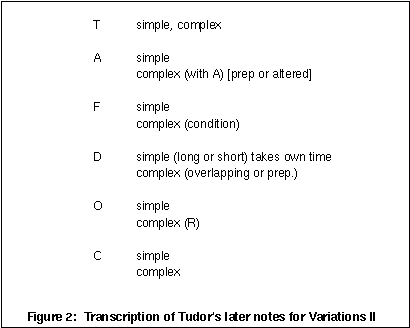
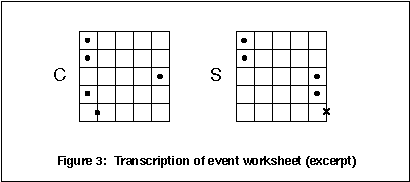
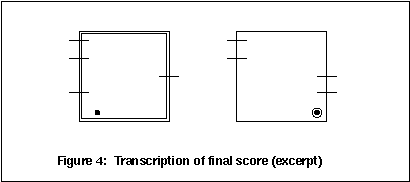
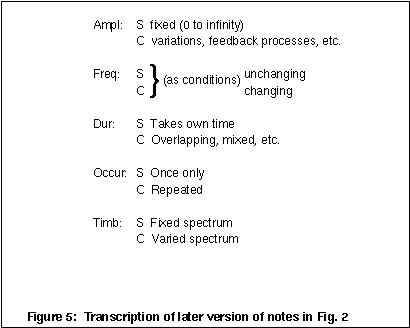
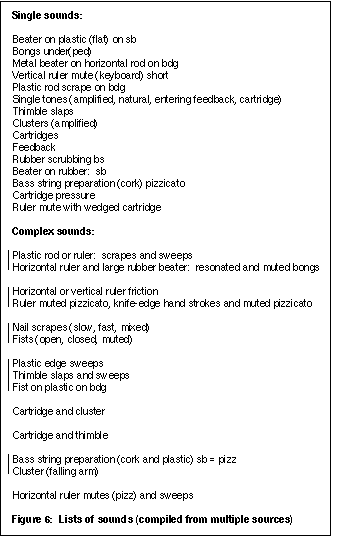
Pingback: The unclear boundary between David Tudor and John Cage : The piano in my life